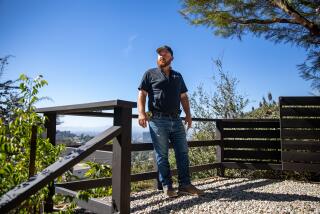Old-Fashioned Chimney Sweeps Are in Hot Demand : Jobs: It’s a quaint occupation, rife with myth. Chimney sweeps bring luck, they say. Not only a safer house, but fertility.
- Share via
When Mike Wilson goes to work, he frequently draws a crowd. There’s just something about a guy climbing around on rooftops in a top hat and tails that seems to turn people’s heads.
Wilson, 33, is a chimney sweep with a South Bay company called Chim Chim Ca Chu. Unlike other such centuries-old professions, his trade has survived and is even flourishing with relatively few concessions to modern technology.
Despite stricter building codes and the improved materials used in residential construction, experts say today’s chimneys still require traditional cleanings every two to three years.
Soot and creosote, a tarry, flammable residue from wood fires, including wood-burning stoves, accumulate on chimney walls. If ignored long enough, sparks from the fireplace can ignite these deposits into a roaring chimney fire reaching temperatures as high as 2,000 degrees Fahrenheit. This can quickly spread to the roof and frame, and in the end could destroy the house.
Even in Southern California’s mild climate, there are sufficient fireplaces to provide work for at least half a dozen contractors in the South Bay alone, who also typically perform masonry repairs and other related services. An average single-story chimney cleaning takes about an hour and costs from $50 to $75--if the homeowner can get on a sweeper’s calendar.
Steven Lovsteen, owner of Oliver Twist Chimney Sweep Service in Rancho Palos Verdes, noted that his staff of five chimney sweeps will service 80 to 100 chimneys a week from December through February, the height of their busy season, and may work seven days a week.
Though the traditional chimney sweep’s attire of top hat and tails is more an affectation nowadays than a necessity--some do it as a means of advertising--the costume had a practical origin.
Because of the dirt and soot inherent in the job, early sweeps needed clothing that could be discarded frequently. To save money, legend has it that they would obtain the castoff clothing of undertakers, who routinely wore formal top hats and tails for funerals. By some accounts, the source of the clothing was the undertakers’ “clients”: the dead.
Some chimney sweep lore isn’t so amusing, said Jerry Marx, owner of The Chimney Sweep in Van Nuys.
“Our profession wasn’t always called chimney sweeps; it was called climbing boys. Some of the more unscrupulous chimney sweeps would advertise: ‘We have the smallest children.’ These children were forced up inside the chimneys (to do the work), that’s why they were called climbing boys. And some of them didn’t get out. They would get stuck in some tight place and suffocate. That’s one of the reasons we have child labor laws.”
Strangely enough, chimney sweeps have long been considered a source of good luck. Historians suggest the notion dates to ancient Rome, where ashes were used in seasonal rituals to increase the fertility of farmers’ fields and livestock.
Perhaps because of the connection between ashes and fertility, chimney sweeps, who spent their working hours covered in ashes, have been invited to European weddings since medieval times. A kiss to the bride from a chimney sweep, or a rub of his top hat, was believed to bring luck (or perhaps fertility) to a newly married couple.
Some modern chimney sweeps have turned this belief to their advantage, as Marx observed when he was a young soldier stationed in West Germany during the 1950s.
“I used to hang out in this little restaurant,” he recalled. “This man would come in at night, and all the young girls wanted to dance with him. I learned that this guy was a chimney sweeper, and in Europe, chimney sweepers are considered good luck. I came home and . . . thought this was a good idea for a business.”
Though the job is usually just a matter of brushing and vacuuming out chimney deposits, inspecting and occasionally repairing the chimney cap, known as a spark arrester, it also can include removing birds or rodents that have crawled in. Most animals end up stranded on the smoke shelf, a structure about halfway up the chimney, which is designed to prevent downdrafts into the fireplace.
Generally, sweeps say, the job is an interesting one. Like the time about 25 years ago when Marx was working at a home in Hollywood, and, on completing the job, was asked to stop in at a place up the street.
There he was greeted by a maid in a starched white uniform, a woman in a tailored business suit, and a third woman dressed in blue jeans. The woman in jeans asked him if he needed access to the roof, and when told that he did, escorted him to the side of the house. She climbed on to a chair balanced on a tabletop, made her way up to the roof and instructed Marx to follow.
“Later, when I came back down and went out to my truck,” Marx recalled, “I said to the maid, ‘That lady looks familiar, is she in the antiques business?’ ”
The maid informed the young man that the woman who clambered ahead of him onto the roof was none other than Katharine Hepburn.
More to Read
Sign up for Essential California
The most important California stories and recommendations in your inbox every morning.
You may occasionally receive promotional content from the Los Angeles Times.











